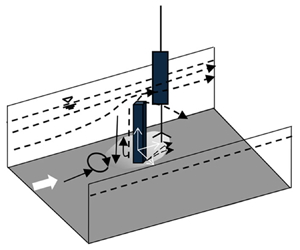Published online by Cambridge University Press: 17 October 2024

Two-dimensional (2-D) quadrant analysis is generally used for investigating flow and sediment dynamics around a rigid structure in open channel flows. Given that particle distribution around rigid obstacles is not spatially uniform and changes in time, while vortices evolve to become three-dimensional (3-D) structures, 2-D quadrant analysis might be unsuitable to completely determine the sediment transport. Hence, 3-D quadrant and 3-D octant analyses should be considered, using the 3-D instantaneous velocity data and relative 3-D bursting process to define sediment transport surrounding the submerged square and circular cylinders. The turbulent kinetic energy (TKE), transition probabilities, occurrence probabilities, stress fraction and angles of inclination of 3-D bursting events are considered to quantify the coherent structures surrounding the cylinders and their interaction with bed particles. Experiments were conducted at the Hydraulics and Water Resources Engineering Laboratory, School of Infrastructure, Indian Institute of Technology, Bhubaneswar, Odisha, India, and velocity data were recorded at different cross-sections around the submerged cylinders using an acoustic Doppler velocimeter. Results show that the TKE is greater for internal ejection, external ejection, and internal sweep, external sweep in the upstream of the circular and square cylindrical structures. On the other part, the TKE is significant for internal ejection, external ejection, and internal sweep, external sweep in the downstream of the aligned square cylindrical structures, which justifies the highest scour depth that occurred upstream of the circular and square cylindrical structures and downstream of the aligned square cylindrical structure. The transition probability of the bursting events was determined using the Markov process from the measured velocity data to investigate the consecutive occurrence of bursting events. Further, the importance of sweeps and ejections on sediment erosion surrounding the cylinders within the scour hole at various stages of its development was investigated via 3-D quadrant analysis of the bursting occurrences. The outcomes show that external sweep and internal ejection events are active mechanisms for bed particle transport surrounding the cylinder. The maximum transition probability values are found around aligned cylindrical structures in comparison with the circular and square cylindrical structures in the transverse direction. This depicts the formation of a trailing vortex on both sides of the aligned square cylindrical object. The results reveal that the effect of inclination angles with respect to the water flow is greater for internal ejection and external sweep from upstream to downstream within the scour hole surrounding the cylindrical structures at various phases of development as horseshoe vortices and downflow develop upstream of the cylindrical structures while trailing vortices and wake vortices form at the top and downstream of the cylindrical structures. Internal and external ejection have a higher stress fraction than an internal and external sweep for square cylinders with alignment angles of 0°, 20° and circular cylinders over underdeveloped and developed scoured beds, respectively. With the higher percentage of fractional contributions for internal sweeps, the external sweep is predicted close to the cylindrical objects in comparison with the internal ejection and external ejection events because of the formation and warping of the horseshoe vortex close to the cylindrical objects, suggesting a significant probability of 3-D bursting occurrences with sediment movement near the cylindrical structures.